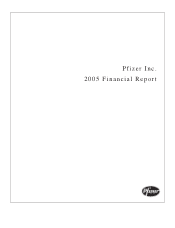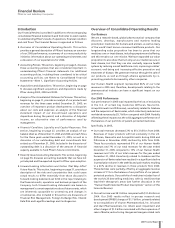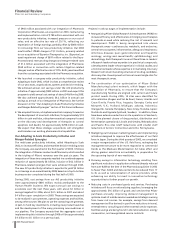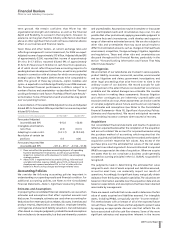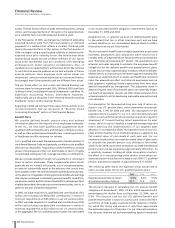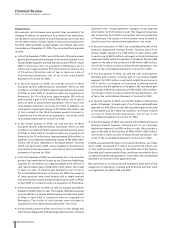Pfizer 2005 Annual Report Download - page 3
Download and view the complete annual report
Please find page 3 of the 2005 Pfizer annual report below. You can navigate through the pages in the report by either clicking on the pages listed below, or by using the keyword search tool below to find specific information within the annual report.
22005 Financial Report
Financial Review
Pfizer Inc and Subsidiary Companies
of $943 million associated with our integration of Pharmacia
Corporation (Pharmacia), an acquisition in 2003; restructuring
and implementation costs of $780 million associated with our
new productivity initiative; increased pressure on our cost of
sales; and an effective tax rate of 29.7%, reflecting our
repatriation of foreign earnings; partially offset by $800 million
in cost savings from our new productivity initiative. Our 2004
results reflect IPR&D charges of $1.1 billion, primarily related
to our acquisition of Esperion Therapeutics, Inc. (Esperion); an
asset impairment charge of $691 million related to the Depo-
Provera brand; restructuring charges and merger-related costs
of $1.2 billion associated with the integration of Pharmacia;
$369 million in connection with certain litigation-related
charges; and an effective tax rate of 19%. Both years benefited
from the cost savings associated with the Pharmacia acquisition.
•We launched a company-wide productivity initiative, called
Adapting to Scale (AtS), which involves a comprehensive review
of our processes, organizations, systems and decision-making.
We achieved annual cost savings under the AtS productivity
initiative of approximately $800 million in 2005 and expect this
program to yield annual cost savings of about $4 billion by 2008.
We also achieved approximately $4.2 billion in annual cost
savings as a result of our integration of Pharmacia. See further
discussion in the “Our Adapting to Scale Productivity Initiative
and Merger-Related Synergies” section of this Financial Review.
•We acquired Vicuron, a biopharmaceutical company focused on
the development of novel anti-infectives, for approximately $1.9
billion in cash and Idun, a biopharmaceutical company focused
on the discovery and development of therapies to control
apoptosis (cell death), for approximately $298 million in cash.
We expect that these strategic acquisitions will strengthen
and broaden our existing pharmaceutical capabilities.
Our Adapting to Scale Productivity Initiative and
Merger-Related Synergies
Our multi-year productivity initiative, called Adapting to Scale
(AtS), to increase efficiency and streamline decision-making across
the Company, was launched in the first quarter of 2005. It follows
the integration of Warner-Lambert and Pharmacia, which resulted
in the tripling of Pfizer’s revenues over the past six years. The
integration of those two companies resulted in a combined expense
reduction of approximately $6 billion, inclusive of $4.2 billion in
Pharmacia-related synergies that were achieved through 2005.
The new AtS productivity initiative is expected to yield $4 billion
in cost savings on an annual basis by 2008, based on a top-to-bottom
business review completed during the first half of 2005.
During 2005, cost savings from our AtS productivity initiative
were approximately $800 million, mainly attributable to the
Human Health business. We expect annual cost savings to
accelerate over the next three years, with about $2 billion in
savings targeted for 2006, about $3.5 billion in 2007 and about
$4 billion upon completion in 2008. These savings are expected
to be realized in procurement, operating expenses and facilities,
among other sources. We plan to use the cost savings we generate,
in part, to fund key investments, including new product launches
and the development of the many promising new medicines in
our pipeline. The Company expects that the aggregate cost of
implementing this initiative through 2008 will be approximately
$4 billion to $5 billion on a pre-tax basis.
Projects in various stages of implementation include:
•Reorganizing Pfizer Global Research & Development (PGRD) to
increase efficiency and effectiveness in bringing new therapies
to patients-in-need while reducing the cost of research and
development. PGRD is being reorganized into eleven
therapeutic areas—cardiovascular, metabolic, and endocrine;
central nervous system; inflammation; allergy and respiratory;
infectious diseases; pain; gastrointestinal and hepatitis;
oncology; urology and sexual health; ophthalmology; and
dermatology. Each therapeutic area will have three co-leaders:
a Research leader whose expertise is in preclinical compounds;
a Development leader whose expertise is in clinical studies; and
a Commercial leader whose expertise is in marketing. Discovery
Research will retain its existing structure of six drug-candidate-
discovery sites. Development will move toward single sites for
most therapeutic areas.
•The continuation of our optimization of Pfizer Global
Manufacturing’s plant network, which began with the
acquisition of Pharmacia, to ensure that the Company’s
manufacturing facilities are aligned with current and future
product needs. During 2005, 14 sites were identified for
rationalization (Angers and Val de Reuil, France; Arecibo and
Cruce Davila, Puerto Rico; Augusta, Georgia; Corby and
Morpeth, U.K.; Holland, Michigan; Jakarta, Indonesia;
Orangeville, Canada; Parsippany, New Jersey; Tsukuba, Japan;
Stockholm and Uppsala-Fyrislund, Sweden). In addition, there
have been extensive reductions in site operations in Sandwich,
U.K. (the planned closure of drug product, distribution and
fermentation operations); Lincoln and Omaha, Nebraska sites;
and Puerto Rico sites (staff reductions), with smaller staff
reductions in Groton, Connecticut and Lititz, Pennsylvania.
•Realigning our European marketing teams and implementing
initiatives designed to improve the effectiveness of our field
force in Japan. During the third quarter of 2005, we completed
a major reorganization of the U.S. field force, reshaping the
management structure to be more responsive to commercial
trends as the Medicare Modernization Act takes effect and
driving greater sales-force accountability in preparation for
the upcoming launch of new medicines.
•Pursuing savings in information technology resulting from
significant reductions in application software (already reduced
from over 8,000 at the time of the Pharmacia acquisition in 2003
to fewer than 3,000) and data centers (to be reduced from 17
to 4), as well as rationalization of service providers, while
enhancing our ability to invest in innovative technology
opportunities to further propel our growth.
•Reducing costs in purchased goods and services. Purchasing
initiatives will focus on rationalizing suppliers, leveraging the
approximately $16 billion of goods and services that Pfizer
purchases annually, improving demand management to
optimize levels of outside services needed and strategic sourcing
from lower-cost sources. For example, savings from demand
management will be derived in part from reductions in travel,
entertainment, consulting and other external service expenses.
Facilities savings are being found in site rationalization, energy
conservation, and renegotiated service contracts.

